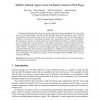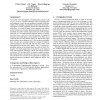36 search results - page 3 / 8 » Reining in the web with content security policy |
CCS
2010
ACM
13 years 11 months ago
2010
ACM
A web mashup is a web application that integrates content from different providers to create a new service, not offered by the content providers. As mashups grow in popularity, ...
CCS
2008
ACM
13 years 6 months ago
2008
ACM
Unrestricted information flows are a key security weakness of current web design. Cross-site scripting, cross-site request forgery, and other attacks typically require that inform...
PET
2009
Springer
13 years 11 months ago
2009
Springer
Many requests that a Web browser makes are not made to the primary site a user is visiting. It is common for websites to instruct browsers to make additional requests to third-part...
USS
2008
13 years 6 months ago
2008
Many web sites embed third-party content in frames, relying on the browser's security policy to protect them from malicious content. Frames, however, are often insufficient i...
CCS
2007
ACM
13 years 10 months ago
2007
ACM
We describe a new attack against web authentication, which we call dynamic pharming. Dynamic pharming works by hijacking DNS and sending the victim’s browser malicious Javascrip...


